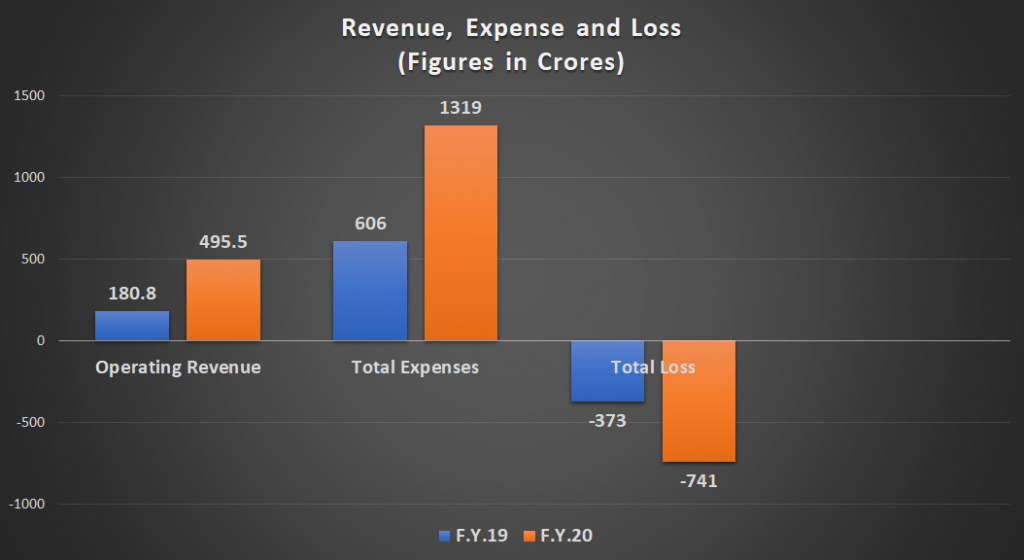Suppose there is one startup that looks after the entire fitness ecosystem. In that case, it has to be ‘CureFit.’ Founded in 2016 by ex-Flipkart employees Mukesh Bansal and Ankit Nagori, it is headquartered in Bengaluru. The business model of Curefit is an innovative blend of coaching, engagement, and delivery through a combination of online and offline channels. Do read why ex-Flipkart employees or Flipsters as they call themselves succeed in their entrepreneurial ventures. If, like me, you are also confused if its Curefir or Cultfit, check out this:
Both the experiences, seamlessly integrated, are aimed to provide end-to-end proactive health management to consumers. This unique solution enables users to enjoy a better quality of life, reduce the probability of getting ill, and significantly reduce the risks of long-term chronic diseases.
At cult.fit, we strive to keep you fit & healthy through a range of holistic offerings that include fitness and yoga, healthy meals, mental wellbeing, and primary care. Now anyone can now stay healthy from the safety of their homes with just a single app that helps you to #BeBetterEveryDay
Cult.fit website
A decade ago, the fitness category in India was hugely underpenetrated as compared to its western counterparts. Also, it was largely unorganized with the majority of local players and very few organized chains like Talwalkar’s, Fitness One, and Fitness First.
However, increasing awareness towards health, appearance, and fitness; and rising disposable income among the young population fuelled the growth of this category. Moreover, the category was yet to be disrupted, even though some application-based start-ups ventured into this space since the late 2010s.
Clear Targeting:
The Founders were clear about their target consumers. It was a ‘Regular person’ and not a ‘body builder’, who required specialized equipment. They believed that to maintain good health, a person needs to do some physical activity, eat at least a few healthy meals daily, sleep well, and go for regular health check-ups.
Health is not standalone. Health is a complex function of diet, fitness, mental wellness, and overall wellbeing. It has to be holistic
Founder Anit Nagori
The Business model of Curefit:
In 2016, Curefit was launched initially post the acquisition of two Bengaluru-based fitness studios, Cult and Tribe. The studios of Cult.fit offered a variety of group workout routines designed around Boxing, Zumba, Kettlebell workouts, Dancing and Yoga, and Strength and Conditioning to make the workout fun and enjoyable. Trainer-led group sessions at Cult.fit enabled its members a space to socialize with each other. These sessions also facilitated members to perform their workouts by observing each other.
The founders believed the availability of Cult.fit studios, unique workouts designed, and their centers’ socialization experience improved customer retention. The breakeven period of a studio was reported to be 15 months. In addition to the design and format of its Cult.fit studios, Curefit also differentiated itself by integrating its offline workouts with the digital platform.
The website of Curefit was launched in 2016 and the Cure.fit app went live in 2017. Customers were onboarded directly through the app. In a first in the fitness industry, customers were required to book their sessions by choosing the center, time, and class format of their preference. The customers were usually waitlisted if the session was fully booked and were allotted a slot if someone dropped out.

Eat.fit:
In 2017, with the acquisition of Kristy’s kitchen, a health food start-up, and Opinio, a hyperlocal food delivery start-up, it set up its food vertical. The Eat.fit offered a subscription-based healthy food delivery service. The food was cooked within strict calorific values in cloud kitchens set up across the city and delivered directly to consumers. A good amount of Eat.fit revenue came from Cult.fit customers with the app using the data collected to suggest healthy food alternatives to its members.
Over time, the company launched its private label for packaged health food and branded it Whole.fit. It sold food items such as cold-pressed juices, beaten grains, healthy crisps, and protein water. The interesting point is that these packaged health foods of Whole.Fit contributed about 30% of Eat.fit’s revenues. In addition to this, Cure.fit app also sold accessories like athletic clothing, footwear, and other fitness accessories under the brand name ‘Cult gear’.
Mind.Fit:
Curefit again chose the Acquisition route to enter the Yoga and mental health vertical. Curefit acquired the yoga studio ‘1000yoga’ in 2017 and re-branded it as Mind.fit. Mind.Fit was offered as an extension of its Cult.fit service. The founders believed that anyone from the age group of 18 to 80 years is a potential member of Mind.Fit.
So, in the long term, Mind.Fit might outgrow Cult. However, Capex-wise, it is relatively small as compared to Cult, as it’s much easier to find space for Mind.Fit. Also, given the popularity of Yoga in India, Mind.Fit can also enjoy a healthy audience in Tier-2 and Tier-3 cities.
Care.Fit:
In 2018, Cure.Fit set up its first healthcare clinic and branded it as Care.fit in Bengaluru. The clinic had doctors who performed health checks and prescribed medication and lifestyle changes to patients, basic diagnostic facilities, and a pharmacy. The company sought to leverage big data, telemedicine, and analytics to offer preventive healthcare solutions to complement its other fitness and wellbeing offerings further.
Revenue Breakdown:
Fitness was the highest-earning vertical for the company contributing 62.4% of the revenues. This was followed by food services, which accounted for 34.5% of revenue. Healthcare and other related services made 3.06% of the earnings.
Cost Structure:
Costs related to employee salary and benefits were one of the largest cost centers for the company accounting for 25% of the expenses. Such costs grew by 84% to Rs 328.6 crore in FY20 from Rs 178.7 crore in FY19. The increase can be attributed to several hundred people Curefit employed as Trainers and for its food vertical, Eat.fit.
The expenditure on advertising and promotion also increased from INR 128.6 cr. to INR 239.5 cr. (Increase of 86.2%)
Kaleyra’s Cloud platform for real-time communication:
Revolutionizing fitness by allowing users to book class slots according to their convenience at a center chosen by the user meant the brand had to step up and bridge the communication gaps between its centers and customers.
Also, with the addition of other services like Eat.fit, Mind.fit and Care.Fit meant addition of more stakeholders. This pushed the brand to look for cloud telephony platforms that were efficient and reliable to meet their requirements. Manual intervention was usually required during network downtimes to switch to other operators which ultimately led to customers raising complaints, affecting its business value.
To maintain real-time communication with customers, the Business model of Curefit used Kaleyra’s messaging platform to deliver message alerts. It would be regarding slot alerts in case of Cult.fit usually about session booked, chosen center, time slot, and booking ID.
Similarly, a message would be triggered from Kaleyra’s platform when the chosen class was canceled by the customer making it easier for other customers to book the slots because of the cancellations. Kaleyra’s Alerts platform also helped to inform customers about other services like when the customers booked a meal through eat.fit, meditation therapy class through Mind.fit or a doctor’s appointment via Care.fit.
Fight against Covid (Redesigned Business Model of Curefit)
When the Cultfit centers closed because of Covid, the business model of Curefit turned its attention to online offerings. Curefit started with live sessions through its Cult.live and Mind.live offerings and increased its library content. The company signed up influencers like Yasmin Karachi Wala (fitness trainer), Mandira Bedi (Actress), and Jonty Rodes (International fielding coach). While the company initially offered the service for free, it started monetizing it since May 2020.
The company introduced a new feature called ‘Energy Meter,’ which virtually tracks the workout movements through the customer’s camera. Post the session, the leader-board is published, and each user gets feedback. The customers can also publish the rank in the community, and they even get badges.
Acquisitions:
On a recent acquisition in 2021, Curefit has acquired Mumbai-based fitness aggregator Fitternity for an undisclosed amount. Co-founder of Curefit, Mukesh Bansal, said with the acquisition of Fitternity, the business model of Curefit will be able to improve its gyms and studios and focus on providing the right tools to adjust to the post-Covid scenario amidst changing consumer habits.
Fitternity is Curefit’s second acquisition this year after it acquired US-Based fitness tech start-up Onyx in January. The purpose of the Onyx acquisition was to improve its computer vision technology for home-fitness products. Onyx specializes in body tracking technology and customization workout feedback. It provides accurate rep counts, form correction, and detailed performance tracking.

Funding and Valuation:
CureFit raised US$110 million in its second Series D funding round led by Singapore-based Temasek Holdings, which invested $71.8 million of the total. According to regulatory filings of March 2020, Curefit issued 2,06,10,687 cumulative convertible preference shares (CCPS) worth INR 539 Cr to Temasek (MacRitchie Investments Pte Ltd)
Existing investors Accel Partners invested about $14.2 million, while Chiratae Ventures and Unilever Swiss Holdings invested $1.8 million and $2.8 million respectively.
Recent News:
Tata Group, India’s conglomerate is in talks to acquire Curefit. It is also planning to bring Mukesh Bansal on board with a leadership role in Tata’s digital business. Curefit could be an excellent fit for Tata Group’s plan of digital mainstream and ambitious super app. The Co-founder could get a much wider role, considering recently acquired majority stakes in Big Basket and 1 Mg. However, the discussions are still not final.
Conclusion:
The vision of Curefit is clear: Build a holistic Ecosystem of health, fitness, and healthcare. Although the pandemic has put a brake on the growth of Curefit, the company has adapted to the situation by launching a host of online services. The business model of Curefit is further fuelled to grow whenever things return to normalcy.
-AMAZONPOLLY-ONLYWORDS-START-
Also, check out our most loved stories below

Why did Michelin, a tire company, decide to rate restaurants?
Is ‘Michelin Star’ by the same Michelin that sells tires, yes, it is! But Why? How a tire company evaluations became most coveted in the culinary industry?

Bajaj Auto: The Story of an Indian Born Global Brand
Bajaj Auto has evolved tremendously over time from its traditional scooter Chetak to having the trendiest bike Pulsar. It has managed to stay relevant.

Jio’s Offensive Marketing Warfare: From Challenger to Leader
In just 4 years Reliance Jio has become the Indian telecom market leader due to its marketing warfare strategies. What is this strategy and how Jio used it?

Johnnie Walker – The legend that keeps walking!
Johnnie Walker is a 200 years old brand but it is still going strong with its marketing strategies and bold attitude to challenge the conventional norms.

Flipsters: Creating the Butterfly effect in Indian Startup Ecosystem
How is it that ex-Flipkart employees or Flipsters as they call themselves have achieved such massive success in the Indian Startup Ecosystem?

Nike doesn’t sell shoes. It sells an idea!!
Nike has built one of the most powerful brands in the world through its benefit based marketing strategy. What is this strategy and how Nike has used it?

Domino’s is not a pizza delivery company. What is it then?
How one step towards digital transformation completely changed the brand perception of Domino’s from a pizza delivery company to a technology company?

Why Indians love Old Monk? What is the revival plan of the dying brand?
Indians especially armed forces and college students for generations have loved Old Monk. What makes this rum so special? It’s classy, dark yet affordable.

IKEA- The new master of Glocalization in India?
IKEA is a global giant. But for India, the brand modified its business strategies. The adaptation strategy by a global brand is called Glocalization
-AMAZONPOLLY-ONLYWORDS-END-

















